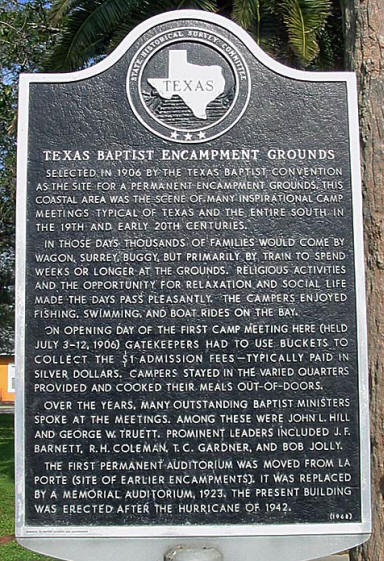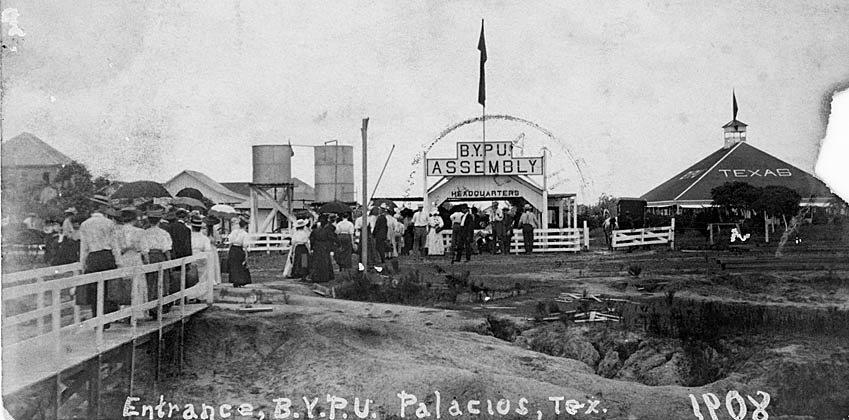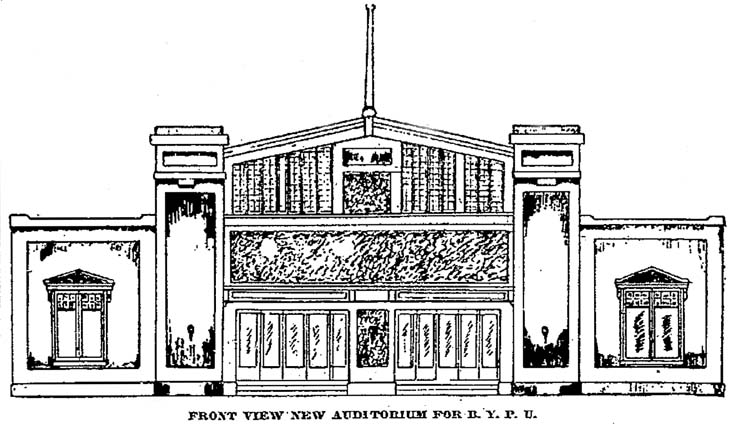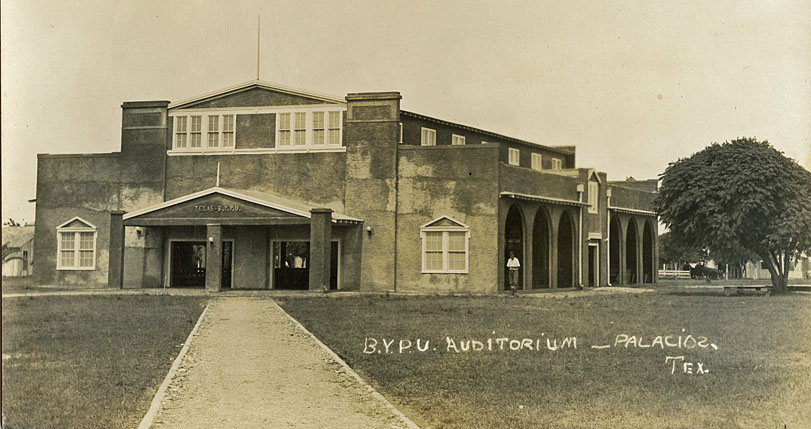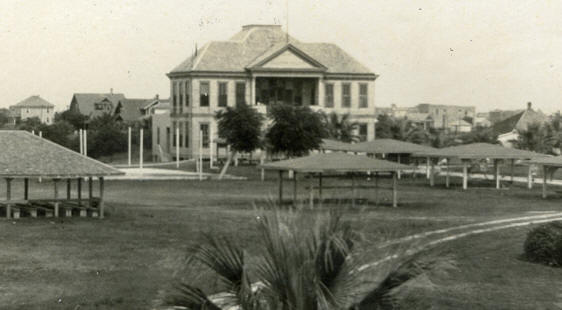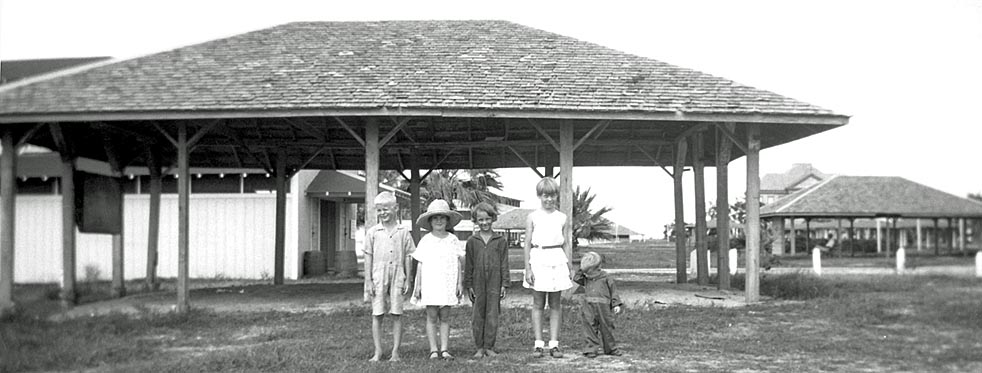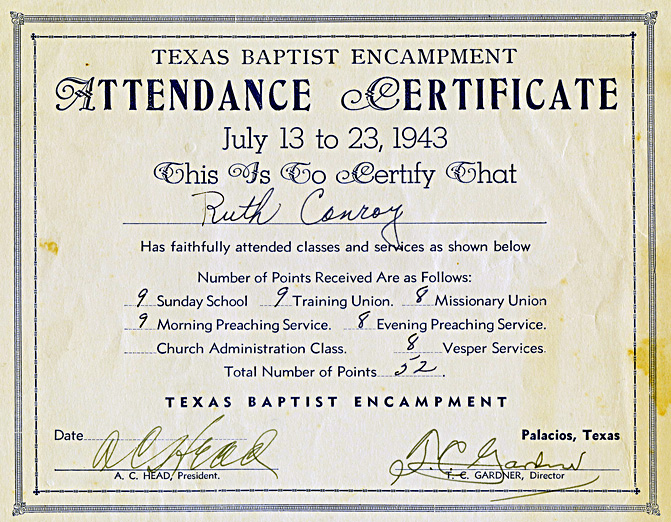|
|
||||
Additional Pictures
1947 Program
Texas Baptist
Encampment
1921 Drownings |
||||
|
||||
|
|
||||
|
The first convention of the Baptist Young Peoples Union (BYPU) was held in Fort Worth on September 9, 1891. After the 11th convention held in Bonn am in 1901, the following resolution was unanimously adopted: “Be it resolved, that the convention appoint a committee to arrange for an encampment next summer at some point where all can meet for some days and enjoy a feast of soul and rest of body.” In 1902 the first encampment was held at La Porte, and steps were taken to purchase a permanent campsite. A beautiful tract of land was purchased 2 miles from La Porte, and in 1905 the first assembly was held there. That year excessive rains cause flooding at the new site. This problem, along with dissatisfaction over failure to secure railroad or street-car connections with the campsite, aroused questions on January 16, 1906, of a new site. W. H. Travis, pastor of first Baptist Church, Palacios, and the president of the Baptist Academy at Palacios, recommended the encampment be moved to Palacios where the Baptist College for South Texas was situated. This suggestion was supported by First Baptist Church, Palacios. There was a great deal of discussion in Dallas concerning the move to better grounds. Meanwhile, Port Lavaca, Corpus Christi, and other places made bids for the encampment. Travis approached W. C. Moore, president of the Palacios Townsite Company, and asked if Palacios would be interested in making an offer to the BYPU. C. J. Wildman was sent to Dallas by the townsite company to confer with officials. An offer was made to give, free of charge, the land known as Hamilton Point to the encampment, provided five consecutive encampments were held on the 13-acre tract. In 1906 Hamilton Point in Palacios became the permanent site selected by the Texas Baptist Convention for the Texas BYPU assembly. J. A. Moreman, a contractor from Plano, Texas, was hired to rebuild the auditorium that was moved from La Porte to Palacios. On July 3 - 12, 1906, the first camp meeting was held on the beautiful grounds of Palacios. These were the only camp facilities in the state and were supported by churches throughout Texas. Speakers for the meetings were brought from around the world. George W. Truett, pastor of First Baptist Church, Dallas, spoke at the 1906 encampment--the first of many visits from this distinguished minister. He preached the opening sermon for the next 18 years. The Rev. Truett loved the encampment, and according to statements made concerning its ministry, he felt that no institution in Texas or the South, and purporting to the investment made, had meant quite so much to Christianity in general, and to Baptist causes and institutions in particular. In the early days, lots were available for churches and individuals to erect their own cottages. According to records, the 25’x50’ lots were not sold but leased for a term of 25 years; the price ranged from$25 to $50. Approximately 500 tents were pitched for campers. Private cabins were available for $4 and $5. Also, a row of rough rooms, called stalls, were made available, and cots for sleeping could be rented for 50₵ a season or if you preferred, a bale of hay was furnished, free of charge. Folding chairs were available for a deposit of 75₵ of which 50₵ was refunded if the chair was returned in “good condition.” For the most part, food was cooked on open fires and charcoal furnaces. For those who preferred a first-class meal, the cost was 25₵ to 35₵ at the restaurant or at the stand on the grounds. Many families came to camp by wagon or buggy, but most came by train. The encampment was used not only for summer camping, but also for mid-week prayer services, Sunday school, and the preaching and hour for First Baptist Church, Palacios. These meetings were held in the restaurant until the church's auditorium was erected on the corner of Second and Welch in 1907. Originally, there was a north entrance to the encampment. In 1908 that entrance was closed, and the main entrance to the encampment was moved to the west side, near First Street at the present location. Every year new cabins were erected on the grounds. Water, lights, gas, and sewer systems were installed. These improvements caused the camp to go in debt. The camp overcame not only this difficulty, but also the problems encountered by two world wars, the depression, and several Gulf storms. The general encampment continued to grow, and in 1917 the enrollment was recorded at 3000 and with 17 states represented. During those early years, Mrs. G. T. Brooking of Palacios was the camp reporter, and for many years she sent the daily news to Galveston for publication. In 1922 fees were raised from $1.00 to $1.50. Cots were now $1.50, and dorm rooms rented for $12.50 a season. Early one morning a group of visitors at the BYPU camp left with Mr. and Mrs. John T. Price of Palacios for a point on Greens Bayou, a site frequently visited by the campers. It is situated on the Gulf approximately 25 miles from Palacios. Upon arriving at their destination on July 21, 1921, the small group disembarked and began what they thought would be a pleasant swim in about 2 feet of water. To their horror, one of the women encountered an undertow which pulled her down. The rescuer also was pulled under and then another and another. John Price made many futile attempts to rescue members of the party, and as a result lost his own life due to apparent heart failure. Four women and four men died in this tragic accident, but only seven bodies were recovered. Eight others of the party narrowly escaped drowning. In 1923 C. W. Caldwell of Abilene donated a beautiful memorial building to replace the tabernacle moved from La Porte. It was given in memory of those who lost their lives in the Gulf tragedy. BYPU underwent a name change in 1931. The organization at that time became known as Baptist Training Union. The Training Union operated through a board of trustees and directors who were responsible to the convention. In 1934 a Gulf storm, which came ashore between Corpus Christi and Palacios, caused considerable damage to the encampment. Following the storm, Henry Bentz was made keeper of the grounds he regarded this as a sacred trust and adopted as his slogan “Worship the Lord in the beauty of Holiness.” In 1935 as the wall was erected around the city of Palacios to help prevent some of the damage caused by tidal waves during a hurricane. Being so closely linked with the city enabled the camp to build a sea wall around its property as well. A new cafeteria, situated near the site of the present cafeteria but closer to the bayshore, was opened for the 1941 summer season. In 1942 a hurricane destroyed the memorial auditorium and damaged other buildings and property. Another auditorium was erected in 1944 to replace the previous structure. On May 9, 1945, the convention in Dallas underwent another name change. This time the camp property was transferred to the Baptist General Convention of Texas. During the first 40 years of the camp's existence, records show over 42,000 rededications, 400 going forth as missionaries, and a similar number publicly professing faith in Christ. In June, 1953, it was decided that Palacios Day would be observed each year on San Jacinto Day. On Palacios Day, all charges were encouraged to pledge support to the camp. In July, 1953, the Baptist General Convention of Texas deeded the camp property to the trustees of the encampment. In order to establish legal ownership, these trustees were named by the state convention. They were to serve until the next camp meeting, at which time the people were to select their own trustees from those present. A new name, Texas Baptist Assembly, was given to the encampment. When the 53rd annual encampment opened on July 6, 1955, a new $20,000 olympic-size swimming pool was added to the recreational attractions. 2000 attended opening night, the largest enrollment in 20 years. During the 1950s, the special attractions included moonlight devotionals on shrimp boats. Harold E. Dye, pastor emeritus of Baptist Temple, San Jose California and author of several books, recalls: I was the speaker for five consecutive years at a youth assembly at Palacios by the Sea, in Texas. One night, after the evening service, we took three thirty-foot shrimp boats loaded with boys and girls out to the middle of the bay for a devotional hour. The vessels kept their rendezvous and were tied together. I climbed to the top of the engine room with the song leader who led in the singing of choruses--a continuation of singing that had been in progress all the way out. Before I spoke, I asked for testimonies. I shall never forget the first I heard. A teenage girl stood up in the stern of our boat. Though her face was a blur in the starlit night, her words were clear. “As we sang ‘Turn Your Eyes Upon Jesus’ I did just that,” she said.” I looked at Him and then into my own heart. I had surrendered to be a foreign Missionary, but fear made me give up. Now I am willing to go anywhere, away from loved ones, friends, home, and country. I saw him and am no longer afraid.” John L. Hill of Nashville, Tennessee, was a frequent speaker at the encampment. On May 24, 1957, a groundbreaking ceremony was held for the amphitheater that bears his name. Rev. Hill expressed his feelings by saying: It was my joy to share the fellowship of Palacios for many years. In my humble judgment, Palacios is a veritable spiritual arsenal for Texas Baptists. From its atmosphere of inspiration, year by year go back into the churches of Texas, armies of precious girls and boys and of talented young men and young women with minds illumined and souls afire, Beautiful in situation, rich in glorious achievements, sacred and blessed associations, God’s men and women are to find and Palacios their golden opportunity to safeguard the future, by investing in the character of the youth who are to make our tomorrow. The Oldham dorms A and B were erected in 1960 by the Oldham Little Church Foundation for use by small churches not having a dorm or housing of their own. In 1961 ownership of the camp was transferred to District 4 of the Baptist General Convention of Texas. On September 10, 1961, the worst disaster in the encampment’s 65-year history occurred. On that date the eye of Hurricane Carla roared through Palacios with winds up to 171 mph. Thirteen dorms and living quarters, dining hall, faculty building, snack shack, and eight pavilions were destroyed. The tabernacle, amphitheater, two new dorms, the Hill House, office buildings, and nine other dormitories were severely damaged. Total loss exceeded $100,000. Thanks to hundreds of volunteers throughout the upper Gulf Coast area, the camp was ready to begin the summer sessions on schedule. The present cafeteria as well as the administration building, constructed from lumber and bricks salvaged from the storm, were completed in time for the 1962 summer camping programs. Pool improvements were made, dorms and the pier repaired, and the amphitheater and tabernacle restored for camp use. Although attendance was only 2, 493 during that summer, there were 192 rededications, 108 accepting God's called the special service, and above all, 135 accepting Christ as Savior. In 1965 the pontoon float, used for moonlight cruises and daytime excursions to Pelican Island, was a featured attraction. The pontoon, however, was condemned by the Coast Guard, and its use was discontinued. Although the eye of Hurricane Beulah (1967) did not hit the coast near Palacios, high water and tornadoes damage some of the buildings and removed the fishing pier. First Baptist Church, Rosenberg, gave their cabin to the camp, and First Baptist Church, Victoria, sold their building to the camp in 1968. (Later in 1976 First Baptist Church, Victoria, deeded their building to the camp clearing the debt.) Baptist Temple of Victoria followed suit and gave their dorm to the encampment. Construction was begun on a Royal Ambassadors (R. A.) lodge and new Oldham building, bringing the total sleeping capacity to 600. In 1969 an official Texas Historical Marker was placed outside the main entrance of the campgrounds. The updating of camp facilities began in 1975. This included painting, air-conditioning and heating the dorms, heating the cafeteria for winter retreats, providing recreation rooms and removing two wooden buildings, that were a real eyesore, from the grounds. One of these two buildings was partially dismantled when arsonists set fire to the remaining structure during the early morning hours in May, 1976. A new recreation pier, 280 feet long with a 50 foot T-head providing ample room for fisherman, was constructed in March, 1976. A smaller boat basin also was constructed to accommodate the sailboats which are part of the recreation program during the summer months. In order to recognize the Baptist associations actively engaged in the support of the encampment, the streets were named Colorado, Guadalupe, San Felipe, Galveston, and Gulf Coast. The main drive, from the entrance to the bay, was designated Martin Lane in memory of C. L. Martin who died in 1975, after serving as manager for 15 years. The bathrooms and all dorm units were remodeled, and fireplaces were installed in the central meeting areas of three dorms. In 1980 palm trees were planted around Bayshore Drive thus allowing the camp property to be lined with palm trees. In July, 1980, final payment was made on a note long overdue. For the first time in 30 years, the camp was free of debt. The Texas Baptist Encampment has had an exciting past, but it can look forward to an even greater future. There is rapid growth along the Gulf Coast area, and the encampment is attempting to plan for the future needs of these people. Other long-range plans include a motel unit, a closed-in tabernacle, a patio near the pool, dressing rooms and bath facilities in the pool area, and the general landscaping of all the property. The responsibility of caring for the property of the Texas Baptist encampment has been given to a few privileged men. Although their titles and duties have very through the years, they have all shared the same dedication to the Lord's ministry. They were: Tom Smith (1912), S. M. Baird (1918), T. A. Bullock (1922), Henry Bentz (1934), John Welmeth (1939), B. L. Millard (1941), J. A. Derrick (1943), B. L. Millard (1946), L. T. Causey (1947), F. C. Carter (1948), Olen Miles (1953), Andy Pate (1958), C. L. Martin (1960), Ulise Thibodeaux (1975), and Stacy Houser (1983).
Historic Matagorda County, Volume I, pp
592-595, 1986 |
||||
|
|
||||
|
The great B. Y. P. U. encampment came to a successful and memorable close with a world wide missionary service Sunday evening conducted by Dr. Gambrell , of Dallas, including addresses by Rev. and Mrs. Buckner returned missionaries from China. Though people by the hundred had already left for their homes, the crowd Sunday night was almost the equal of that the preceeding Sunday, and was far beyond the seating capacity of the auditorium. Though the crowd was the greatest ever assembled at an encampment, there was scarce an incident of petty misdemeanors or unruliness, which are seemingly unavoidable in large assemblies, and not a happening worthy of note to in any way mar the enjoyment or disturb the peace of any who attend. And so the encampment grows bigger and better every year, and is rapidly reaching the stage of a world power in the religious life of the people and for the uplift of humanity, and demonstrating how people may have a season of rest, recreation and pleasure in a rational and really beneficial way. The big part of the crowd left for their homes Monday on the regular and a special train, later stayers going every day since, while a considerable number have remained to spend the remainder of the summer in the cottages of the encampment grounds.
Palacios Beacon, July 20, 1917 |
||||
|
Working against wind and tide and time the contractors finally got the fine boys' dormitory completed so that the boys could move in on the morning of the B. Y. P. U. Convention. Down stairs there are three rooms twenty by twenty-four and two hallways twelve by twenty-four, and twelve by thirty-six feet. Upstairs there are two rooms twenty-four by twenty-four feet, one twenty-seven by forty-eight, and a front porch ten by twenty-seven feet. Sleeping porches up and down stairs will be built making more than five hundred linear feet will be built soon, making one of the best camp buildings anywhere.
Palacios Beacon, July 29, 1921 |
||||
|
New Auditorium In Use On Grounds The new auditorium has finally been completed, and is now being used by the great congregation which gather to hear the speakers of the B. Y. P. U. encampment. This spacious building has many interesting features, and is far superior to the anticipated structure which stood in the same place last summer. It is of stucco, rectangular in shape, and considerably larger than the former auditorium. The woodwork is stained brown, as well as the seats. The stage is capacious, and over it is constructed a curved sounding board from which music is reflected in full volume out over the audience. The neatly sanded floor, the high arched openings, and the constant play of the cool sea breezes keep in mind the fact that the auditorium is a tabernacle in character; otherwise, the building is so fine that many church buildings might well envy it. Palomar students are wondering if they will not perhaps fall heir to this auditorium for a chapel after the encampment has closed its best session, folded its cots and silently stole away in the night.
Palomar Kamper, Palacios Beacon, July 8, 1922 |
||||
|
|
||||
|
Every camper with any curiosity has noticed and wondered about the new structure which is being completed on the encampment grounds. It is being constructed by the State B. Y. P. U. under the personal supervision of Mr. H. L. Shaw, architect and builder, at an approximate cost of $12,000. It is to be finished in stucco and is constructed on the classic style. It is equipped with a large space for any entertainment and it is to be completed with all possible conveniences. The building is to remain an open air strucure through the summer, but will be converted into a closed building in the fall and early winter. It was started on May 10 and is to be completed before the opening of the annual B. Y. P. U. encampment on July 4. The building is somewhat larger than the one which was previously located on that spot. It has a seating capacity of 2,200 people and will be dedicated at the opening of the encampment. After this new auditorium has been finished, it will be at the disposal of the Camp Palomar students as an auditorium and chapel. The acoustics of the new building are excellent, a fine sounding board being in place over the stage, and the singing of the Palomar Vocal artists will be displayed to the best advantage.
Palomar Kamper, Palacios Beacon, July 21, 1922 |
||||
|
The building proper of the new $20,000 tabernacle in the Baptist Encampment grounds will be completed by the middle of next week, L. T. Causey, manager of the grounds, informs us. Erwin Newsom, of Houston, is the contractor and expects to have all the finishing work competed and ready for use by the first of June. As soon as the roof is completed wiring and installing of lights will be started and choir loft constructed, platform and seats arranged. The tabernacle is 80 feet wide by 106 feet long, constructed of steel, with side panels and oval corrugated iron roof on a concrete foundation. The east end will be enclosed except there are windows for light ventilation. The ceiling is 20 feet and the corrugated iron wall extends down 8 feet from the ceiling. At this point there are hinged doors, 12 feet long which can be lifted during good weather, closed and bolted during bad weather. Encampment schedules open May 14, and the grounds will be occupied practically the entire time for such activities throughout the remainder of the summer.
Palacios Beacon, May 1, 1947 |
||||
|
||||
|
|
||||
|
|
||||
|
|
||||
